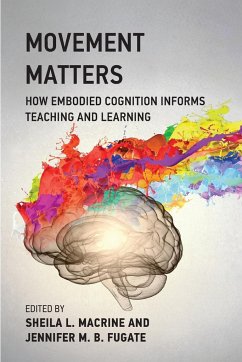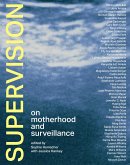Sheila L. Macrine, Jennifer M.B. FugateHow Embodied Cognition Informs Teaching and Learning
Movement Matters
How Embodied Cognition Informs Teaching and Learning
Herausgeber: Macrine, Sheila L.; Fugate, Jennifer M. B.
Sheila L. Macrine, Jennifer M.B. FugateHow Embodied Cognition Informs Teaching and Learning
Movement Matters
How Embodied Cognition Informs Teaching and Learning
Herausgeber: Macrine, Sheila L.; Fugate, Jennifer M. B.
- Broschiertes Buch
- Merkliste
- Auf die Merkliste
- Bewerten Bewerten
- Teilen
- Produkt teilen
- Produkterinnerung
- Produkterinnerung
"Presents the latest research on embodied cognition's applications for educational practices, and offers perspectives on how the relationships among mind, brain, body, and environments impact learning"--
Andere Kunden interessierten sich auch für
![Teaching Community Teaching Community]() bell hooksTeaching Community57,99 €
bell hooksTeaching Community57,99 €![Colour Matters Colour Matters]() Carl E. JamesColour Matters60,99 €
Carl E. JamesColour Matters60,99 €![Data Feminism Data Feminism]() Catherine D'IgnazioData Feminism21,99 €
Catherine D'IgnazioData Feminism21,99 €![The High Price of Materialism The High Price of Materialism]() Tim KasserThe High Price of Materialism25,99 €
Tim KasserThe High Price of Materialism25,99 €![Techniques of the Observer Techniques of the Observer]() Jonathan CraryTechniques of the Observer37,99 €
Jonathan CraryTechniques of the Observer37,99 €![Experienced Wholeness Experienced Wholeness]() Wanja Wiese (Assistant Researcher and Johannes Gutenberg- LecturerExperienced Wholeness54,99 €
Wanja Wiese (Assistant Researcher and Johannes Gutenberg- LecturerExperienced Wholeness54,99 €![Supervision Supervision]() Jessica HankeySupervision24,99 €
Jessica HankeySupervision24,99 €-
-
-
"Presents the latest research on embodied cognition's applications for educational practices, and offers perspectives on how the relationships among mind, brain, body, and environments impact learning"--
Hinweis: Dieser Artikel kann nur an eine deutsche Lieferadresse ausgeliefert werden.
Hinweis: Dieser Artikel kann nur an eine deutsche Lieferadresse ausgeliefert werden.
Produktdetails
- Produktdetails
- Verlag: MIT Press Ltd
- Seitenzahl: 352
- Erscheinungstermin: 19. April 2022
- Englisch
- Abmessung: 229mm x 152mm x 21mm
- Gewicht: 578g
- ISBN-13: 9780262543484
- ISBN-10: 0262543486
- Artikelnr.: 63197702
- Herstellerkennzeichnung
- Libri GmbH
- Europaallee 1
- 36244 Bad Hersfeld
- gpsr@libri.de
- Verlag: MIT Press Ltd
- Seitenzahl: 352
- Erscheinungstermin: 19. April 2022
- Englisch
- Abmessung: 229mm x 152mm x 21mm
- Gewicht: 578g
- ISBN-13: 9780262543484
- ISBN-10: 0262543486
- Artikelnr.: 63197702
- Herstellerkennzeichnung
- Libri GmbH
- Europaallee 1
- 36244 Bad Hersfeld
- gpsr@libri.de
Sheila L. Macrine is Professor in the Department of STEM Education and Teacher Development at the University of Massachusetts Dartmouth. Jennifer M. B. Fugate is Associate Professor in the Department of Health Service Psychology at Kansas City University.
Acknowledgments xi
Foreword xiii
Introduction 1
I PHILOSOPHICAL AND THEORETICAL BACKGROUND
1 Embodied Cognition and Its Educational Significance 13
2 Embodied Concepts: Basic Mechanisms and Their Implications for Learning
and Memory 25
3 Embodied, Enactive Education: Conservative versus Radical Approaches 39
II LANGUAGE
4 The Embodiment of Letter Perception: The Importance of Handwriting in
Early Childhood 55
5 Embodied Classroom Activities for Vocabulary Acquisition 77
6 Educational Applications of Enacted, Embodied Approaches to Language
Comprehension 91
7 Reading, Writing, Technology, and Embodiment 103
III STEM
8 Seeing Is Achieving: The Importance of Fingers, Touch, and Visual
Thinking to Mathematics Learners 121
9 Groups That Move Together, Prove Together: Collaborative Gestures and
Gesture Attitudes among Teachers Performing Embodied Geometry 131
10 Manipulatives and Mathematics Learning: The Roles of Perceptual and
Interactive Features 147
11 Physics and Gesture: Spatial Thinking and Mutual Manifestness 163
IV APPLIED TECHNOLOGY
12 Responsive Teaching for Embodied Learning with Technology 179
13 The Need for SpEED: Reimagining Accessibility through Special Education
Embodied Design 197
14 Immersive Learning Experiences in Augmented Reality (AR): Visualizing
and Interacting with Magnetic Fields 217
15 Evaluating Embodied Immersive STEM VR Using the Quality of Education in
Virtual Reality Rubric (QUIVRR) 237
V SOCIAL COGNITION, EMOTION, MINDFULNESS
16 Mirror Neurons and Social Implications for the Classroom 261
17 Beyond the Social Domain: Autism Spectrum Traits and the Embodiment of
Manipulable Object Concepts 275
18 Embodied Emotion, Emotional Granularity, and Mindfulness: Improved
Learning in the Classroom 291
Conclusion 307
Resources 317
Contributors 323
Index 327
Foreword xiii
Introduction 1
I PHILOSOPHICAL AND THEORETICAL BACKGROUND
1 Embodied Cognition and Its Educational Significance 13
2 Embodied Concepts: Basic Mechanisms and Their Implications for Learning
and Memory 25
3 Embodied, Enactive Education: Conservative versus Radical Approaches 39
II LANGUAGE
4 The Embodiment of Letter Perception: The Importance of Handwriting in
Early Childhood 55
5 Embodied Classroom Activities for Vocabulary Acquisition 77
6 Educational Applications of Enacted, Embodied Approaches to Language
Comprehension 91
7 Reading, Writing, Technology, and Embodiment 103
III STEM
8 Seeing Is Achieving: The Importance of Fingers, Touch, and Visual
Thinking to Mathematics Learners 121
9 Groups That Move Together, Prove Together: Collaborative Gestures and
Gesture Attitudes among Teachers Performing Embodied Geometry 131
10 Manipulatives and Mathematics Learning: The Roles of Perceptual and
Interactive Features 147
11 Physics and Gesture: Spatial Thinking and Mutual Manifestness 163
IV APPLIED TECHNOLOGY
12 Responsive Teaching for Embodied Learning with Technology 179
13 The Need for SpEED: Reimagining Accessibility through Special Education
Embodied Design 197
14 Immersive Learning Experiences in Augmented Reality (AR): Visualizing
and Interacting with Magnetic Fields 217
15 Evaluating Embodied Immersive STEM VR Using the Quality of Education in
Virtual Reality Rubric (QUIVRR) 237
V SOCIAL COGNITION, EMOTION, MINDFULNESS
16 Mirror Neurons and Social Implications for the Classroom 261
17 Beyond the Social Domain: Autism Spectrum Traits and the Embodiment of
Manipulable Object Concepts 275
18 Embodied Emotion, Emotional Granularity, and Mindfulness: Improved
Learning in the Classroom 291
Conclusion 307
Resources 317
Contributors 323
Index 327
Acknowledgments xi
Foreword xiii
Introduction 1
I PHILOSOPHICAL AND THEORETICAL BACKGROUND
1 Embodied Cognition and Its Educational Significance 13
2 Embodied Concepts: Basic Mechanisms and Their Implications for Learning
and Memory 25
3 Embodied, Enactive Education: Conservative versus Radical Approaches 39
II LANGUAGE
4 The Embodiment of Letter Perception: The Importance of Handwriting in
Early Childhood 55
5 Embodied Classroom Activities for Vocabulary Acquisition 77
6 Educational Applications of Enacted, Embodied Approaches to Language
Comprehension 91
7 Reading, Writing, Technology, and Embodiment 103
III STEM
8 Seeing Is Achieving: The Importance of Fingers, Touch, and Visual
Thinking to Mathematics Learners 121
9 Groups That Move Together, Prove Together: Collaborative Gestures and
Gesture Attitudes among Teachers Performing Embodied Geometry 131
10 Manipulatives and Mathematics Learning: The Roles of Perceptual and
Interactive Features 147
11 Physics and Gesture: Spatial Thinking and Mutual Manifestness 163
IV APPLIED TECHNOLOGY
12 Responsive Teaching for Embodied Learning with Technology 179
13 The Need for SpEED: Reimagining Accessibility through Special Education
Embodied Design 197
14 Immersive Learning Experiences in Augmented Reality (AR): Visualizing
and Interacting with Magnetic Fields 217
15 Evaluating Embodied Immersive STEM VR Using the Quality of Education in
Virtual Reality Rubric (QUIVRR) 237
V SOCIAL COGNITION, EMOTION, MINDFULNESS
16 Mirror Neurons and Social Implications for the Classroom 261
17 Beyond the Social Domain: Autism Spectrum Traits and the Embodiment of
Manipulable Object Concepts 275
18 Embodied Emotion, Emotional Granularity, and Mindfulness: Improved
Learning in the Classroom 291
Conclusion 307
Resources 317
Contributors 323
Index 327
Foreword xiii
Introduction 1
I PHILOSOPHICAL AND THEORETICAL BACKGROUND
1 Embodied Cognition and Its Educational Significance 13
2 Embodied Concepts: Basic Mechanisms and Their Implications for Learning
and Memory 25
3 Embodied, Enactive Education: Conservative versus Radical Approaches 39
II LANGUAGE
4 The Embodiment of Letter Perception: The Importance of Handwriting in
Early Childhood 55
5 Embodied Classroom Activities for Vocabulary Acquisition 77
6 Educational Applications of Enacted, Embodied Approaches to Language
Comprehension 91
7 Reading, Writing, Technology, and Embodiment 103
III STEM
8 Seeing Is Achieving: The Importance of Fingers, Touch, and Visual
Thinking to Mathematics Learners 121
9 Groups That Move Together, Prove Together: Collaborative Gestures and
Gesture Attitudes among Teachers Performing Embodied Geometry 131
10 Manipulatives and Mathematics Learning: The Roles of Perceptual and
Interactive Features 147
11 Physics and Gesture: Spatial Thinking and Mutual Manifestness 163
IV APPLIED TECHNOLOGY
12 Responsive Teaching for Embodied Learning with Technology 179
13 The Need for SpEED: Reimagining Accessibility through Special Education
Embodied Design 197
14 Immersive Learning Experiences in Augmented Reality (AR): Visualizing
and Interacting with Magnetic Fields 217
15 Evaluating Embodied Immersive STEM VR Using the Quality of Education in
Virtual Reality Rubric (QUIVRR) 237
V SOCIAL COGNITION, EMOTION, MINDFULNESS
16 Mirror Neurons and Social Implications for the Classroom 261
17 Beyond the Social Domain: Autism Spectrum Traits and the Embodiment of
Manipulable Object Concepts 275
18 Embodied Emotion, Emotional Granularity, and Mindfulness: Improved
Learning in the Classroom 291
Conclusion 307
Resources 317
Contributors 323
Index 327








